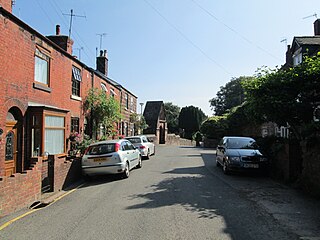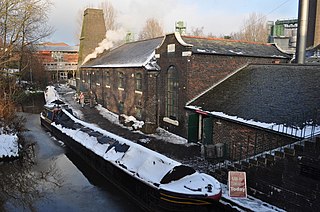
Staffordshire is a landlocked county in the West Midlands of England. It borders Cheshire to the northwest, Derbyshire and Leicestershire to the east, Warwickshire to the southeast, the West Midlands County and Worcestershire to the south, and Shropshire to the west.

The River Churnet is a river in Staffordshire, England. It is a tributary of the River Dove.

Stone is a market town and civil parish in Staffordshire, England, 7 miles (11 km) north of Stafford, 7 miles (11 km) south of Stoke-on-Trent and 15 miles (24 km) north of Rugeley. It was an urban district council and a rural district council before becoming part of the Borough of Stafford in 1974.

Staffordshire is a landlocked county in the West Midlands of England. It adjoins Cheshire to the north west, Derbyshire and Leicestershire to the east, Warwickshire to the south east, West Midlands and Worcestershire to the south, and Shropshire to the west. The historic county of Staffordshire includes Wolverhampton, Walsall, and West Bromwich, these three being removed for administrative purposes in 1974 to the newWest Midlands authority. The resulting administrative area of Staffordshire has a narrow southwards protrusion that runs west of West Midlands to the border of Worcestershire. The city of Stoke-on-Trent was removed from the admin area in the 1990s to form a unitary authority, but is still part of Staffordshire for ceremonial and traditional purposes.

The Staffordshire Potteries is the industrial area encompassing the six towns Burslem, Fenton, Hanley, Longton, Stoke and Tunstall, that now make up the city of Stoke-on-Trent in Staffordshire, England. North Staffordshire became a centre of ceramic production in the early 17th century, due to the local availability of clay, salt, lead and coal.

Barlaston is a village and civil parish in the borough of Stafford in the county of Staffordshire, England. It is roughly halfway between the city of Stoke-on-Trent and the small town of Stone. According to the 2001 census the population of the parish was 2,659, rising at the 2011 Census to 2,858.

Trentham is a suburb of the city of Stoke-on-Trent in North Staffordshire, England, south-west of the city centre and south of the neighbouring town of Newcastle-under-Lyme. It is separated from the main urban area by open space and by the Trent and Mersey Canal and the River Trent, giving it the feel of a village.

Cheddleton Flint Mill is a water mill situated in the village of Cheddleton in the English county of Staffordshire. The mill race takes water from the river Churnet and the site is believed to have been used for milling since the Middle Ages. However, the present structures date from the period of the Industrial Revolution.
The Sentinel is a daily regional newspaper circulating in the North Staffordshire and South Cheshire area. It is currently owned by Reach plc and based at Hanley, Stoke-on-Trent.. Its sister website is StokeonTrentLive. Originally delivering news to the residents of North Staffordshire and South Cheshire via its website, the website and it's mobile application now primarily focuses on clickbait to attract comments from its readers.

Cheddleton is an ancient parish and village in the Staffordshire Moorlands, near to the town of Leek, England.

Penkhull is a township within Stoke-upon-Trent in the city of Stoke-on-Trent in the English county of Staffordshire. The township is part of the Penkhull and Stoke electoral ward, and the Stoke Central parliamentary constituency.

The Wom Brook is a stream in South Staffordshire, England. It flows through the large village of Wombourne, and has played an important part in its industrial history. It is an important tributary of the River Smestow and part of the Severn catchment.

The Etruria Industrial Museum is located in Etruria, Staffordshire, in England. The museum is a typical and well-preserved example of a nineteenth century British steam-powered potter's mill. It is situated between the Trent and Mersey Canal and the Etruria staircase locks of the Caldon Canal. The museum has a modern entrance building, leading into a Grade II* listed building which was formerly the Etruscan bone and flint mill. The mill is also a scheduled monument.

Oulton is a small village in the English county of Staffordshire. The village is located north of the market town of Stone and near to the Trent and Mersey Canal. In 2020 it had an estimated population of 597.

Chell is a suburb of the city of Stoke-on-Trent in Staffordshire, England, that can be subdivided into Little Chell, Great Chell and Chell Heath. It lies on the northern edge of the city, approximately 1-mile (1.6 km) from Tunstall, 2 miles (3.2 km) from Burslem and 3 miles (4.8 km) from the county border with Cheshire. Chell borders Pitts Hill to the west, Tunstall to the south west, Stanfield and Bradeley to the south, with the outlying villages of Packmoor and Brindley Ford to the north and Ball Green to the east. Since 2011 the area has been divided into the electoral wards of Bradeley & Chell Heath, Great Chell & Packmoor and Little Chell & Stanfield.

Pirehill is a hundred in the county of Staffordshire, England. The Hundred is located in the north-west and toward the upper centre of Staffordshire. It is about 28 miles in length, north to south, and around 8 to 20 miles in breadth. It is bounded on the north-east by Totmonslow (Totmanslow) Hundred, on the east by Offlow Hundred, on the south by Cuttleston Hundred and on the west and north-west by Shropshire and Cheshire.

The Stoke-on-Trent Green Belt is a green belt environmental and planning policy that regulates the rural space throughout mainly the West Midlands region of England. It is contained within the counties of Cheshire and Staffordshire. Essentially, the function of the designated area is to prevent surrounding towns and villages within the Stoke-on-Trent conurbation from further convergence. It is managed by local planning authorities on guidance from central government.
Stone Rural is a civil parish in the Borough of Stafford, Staffordshire, England. It contains 39 listed buildings that are recorded in the National Heritage List for England. Of these, three are at Grade II*, the middle of the three grades, and the others are at Grade II, the lowest grade. The parish contains areas around the town of Stone and includes the villages of Aston-By-Stone to the south, and Meaford, Moddershall, and Oulton to the south. The Trent and Mersey Canal runs through the parish, and the listed buildings associated with this are two bridges and two mileposts. The Moddershall Valley contained a number of watermills and what remains of some of these are listed. Most of the other listed buildings are houses and cottages and associated structures, farmhouses and farm buildings, and the rest of the listed buildings include churches, and a house later used as an abbey. The listed buildings within the town of Stone are in Listed buildings in Stone, Staffordshire.
























